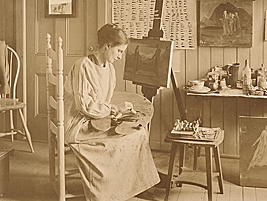Agnes Lawrence Pelton facts for kids
Quick facts for kids
Agnes Pelton
|
|
|---|---|

Agnes Pelton in the studio, estimate 1910s
|
|
| Born | August 22, 1881 |
| Died | March 13, 1961 (aged 79) |
| Resting place | San Jacinto Mountains |
| Nationality | American |
| Education | Arthur Wesley Dow |
| Alma mater | Pratt Institute |
| Known for | Painting |
| Style | Abstract |
| Movement | Transcendental Painting Group |
Agnes Lawrence Pelton (1881–1961) was an important American artist. She was known for her unique style of painting. Agnes was born in Germany but moved to the United States when she was a child.
She studied art in both the U.S. and Europe. Her paintings included portraits of Pueblo Native Americans. She also painted beautiful desert landscapes and still lifes (paintings of objects). Agnes Pelton's art changed over time. She started with "Imaginative Paintings." Later, she painted people and places from the American Southwest. Finally, she created abstract art that showed her spiritual ideas.
Contents
Agnes Pelton's Early Life
Agnes Lawrence Pelton was born in Stuttgart, Germany. Her parents, William and Florence Pelton, were American. She lived in the Netherlands and Switzerland as a young child. In 1888, when Agnes was about 7 years old, she moved to Brooklyn, New York, with her mother.
Agnes was educated at home because of her poor health. Her mother taught her many things. She also learned to play the piano.
Her Education in Art
Agnes Pelton studied at the Pratt Institute from 1895 to 1900. She graduated with another famous artist, Max Weber. She continued her art studies with one of her teachers, Arthur Wesley Dow. He taught her in Ipswich, Massachusetts.
Dow taught a style called Modernism. It was inspired by Chinese and Japanese art. He taught artists to focus on shapes and colors. He also taught them to use their imagination. Dow's ideas helped Agnes create her abstract art. He also taught another famous artist, Georgia O'Keeffe. Agnes also studied in Italy in 1910 and 1911. She learned about Italian painters there.
Agnes Pelton's Art Career
Agnes Pelton's art was shown in Maine in 1912. Because of this show, she was invited to a very important art event. It was called the Armory Show in 1913. Two of her paintings were shown there.
From 1911 to 1917, she made "Imaginative Paintings." These paintings showed how natural light looked.
Her art changed a lot after she visited Taos, New Mexico, in 1919. She started painting realistic portraits and desert scenes. She used oil paints and pastels for these works. Her paintings were shown in Santa Fe. Agnes also visited Pueblo Native Americans in the American Southwest.
Agnes Pelton had her art studios in New York City. In 1921, she moved to Long Island. She lived in a windmill that was turned into a house. She also traveled to places like Hawaii and California.
In 1923 and 1924, she painted portraits and still lifes in Hawaii. By 1926, she began creating abstract art. These works were shown in New York. She had already been in many art shows by then.
In 1932, she moved to Cathedral City, California. She planned to visit, but she ended up living there for almost 30 years.
Agnes Pelton was very interested in spiritual ideas. These ideas influenced her art. She was friends with other artists and thinkers. In 1938, she helped start the Transcendental Painting Group. She was the first president of this group. Agnes Pelton passed away in Cathedral City in 1961.
Exhibitions and Her Legacy
After Agnes Pelton died, her art became more well-known. An exhibition called "Agnes Pelton, Poet of Nature" helped bring attention to her work. This show traveled in 1995 and 1996.
In 2009, her art was shown with three other Modernist artists. These included Georgia O'Keeffe and Agnes Martin. The Phoenix Art Museum held a big exhibition of her work in 2019. The Whitney Museum of American Art also had a show about her in 2020. It was called "Agnes Pelton: The Desert Transcendentalist."
The Agnes Pelton Society was started in 2013. Its goal is to share information about Agnes Pelton's life and art.
Collections
- Honolulu Museum of Art, Hawaii
- The Raymond Jonson Collection, University of New Mexico Art Museum, Albuquerque
- New Mexico Museum of Art
- Oakland Museum of California
- Palm Springs Art Museum, California
- Palladino/Den Historic Home of Agnes Pelton, Cathedral City Cove, California
- Parrish Art Museum, Southampton, New York
- Phoenix Art Museum, Arizona: Messengers, 1932; Day, 1935
- San Diego Museum of Art, California: The Primal Wing, 1933
- Santa Barbara Museum of Art, California
- Sussman Staying Visible Collection, Foothill DeAnza Community College District, Cupertino, California.
- Whitney Museum of American Art, New York: Untitled abstract, 1931
- Crystal Bridges Museum, Arkansas: Divinity Lotus, 1929
Sources
- Severson, Don R. Finding Paradise: Island Art in Private Collections, University of Hawaii Press, 2002, p. 120.



